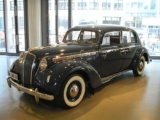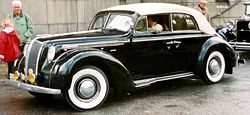
Opel Admiral
Encyclopedia
The Opel Admiral was a luxury car made by the German
car manufacturer Opel
from 1937 to 1939 and again from 1964 to 1977.
 The first Admiral was introduced in 1937 as an attempt to challenge large luxury cars from Horch
The first Admiral was introduced in 1937 as an attempt to challenge large luxury cars from Horch
, Mercedes-Benz
and Maybach
. It was available as a 4-door saloon or cabriolet. The car was equipped with a 3.6 litre straight 6 with a top speed of 132 km/h (82 mph). The production of the Admiral was cancelled in 1939 when the Opel factory started producing war
material.
, Admiral, Diplomat
) models. The Admiral served as the middle model in this three-car range and was equipped with either a 2.6 litre straight-6 OHV of 100 PS providing a top speed of 158 km/h (98 mph), and, from September 1965, with a 2.8 liter-straight six CIH of 125 PS, that made the car reach a top speed of 170 km/h (106 mph). The 2.6l straight-six was discontinued in 1965. Additionally, the Admiral could be equipped with the Chevrolet
-sourced 4.6 l-V8 also used in the Opel Diplomat
. In late 1967, a new two-barrel HL version of the 2.8 l six (140 PS) was introduced. At the same time, all KAD models received rub strips on their flanks, a reworked ZF
recirculating ball steering and a collapsible steering column
.
From 1964 to 1968, Opel produced a total of 55,876 Admirals (out of a grand total of 89,277 KAD cars, making the Admiral by far the most popular of the three).
in 1978.
Over the whole production run, the Admiral B was available exclusively with a 2.8 liter-inline six in either 1-bbl (132 PS Opel Admiral) or 2-bbl (145 PS Opel Admiral 2800 S) form or with fuel injection (165 PS Opel Admiral E). This was the first time fuel injection had been offered as an option in an Opel. All engines could be paired with a 4-speed manual or with Opel's own 3-speed automatic transmission. From January 1972 the manual was no longer available with the Admiral E, leaving the automatic as the only choice. For the back axle, the big change for the Admiral B was the fitting of a De Dion tube based suspension.
For the model year 1975, the six was reworked and downrated to 129/140/160 PS in a move to reduce emissions.
Opel built about 33,000 Admiral B models from 1969 to 1977.
Germany
Germany , officially the Federal Republic of Germany , is a federal parliamentary republic in Europe. The country consists of 16 states while the capital and largest city is Berlin. Germany covers an area of 357,021 km2 and has a largely temperate seasonal climate...
car manufacturer Opel
Opel
Adam Opel AG, generally shortened to Opel, is a German automobile company founded by Adam Opel in 1862. Opel has been building automobiles since 1899, and became an Aktiengesellschaft in 1929...
from 1937 to 1939 and again from 1964 to 1977.
Admiral (1937–39)

Horch
Horch was a car brand manufactured in Germany by August Horch & Cie, at the beginning of the 20th century.-History at a Glance:The company was established first by August Horch and his first business partner Salli Herz on November 14, 1899 at Ehrenfeld, Cologne. August Horch was a former production...
, Mercedes-Benz
Mercedes-Benz
Mercedes-Benz is a German manufacturer of automobiles, buses, coaches, and trucks. Mercedes-Benz is a division of its parent company, Daimler AG...
and Maybach
Maybach
Maybach-Motorenbau GmbH is a German luxury car manufacturer. It was founded in 1909 by Wilhelm Maybach and his son. The company was originally a subsidiary of Luftschiffbau Zeppelin GmbH and was itself known as Luftfahrzeug-Motorenbau GmbH until 1912.Today, the ultra-luxury car brand is owned by...
. It was available as a 4-door saloon or cabriolet. The car was equipped with a 3.6 litre straight 6 with a top speed of 132 km/h (82 mph). The production of the Admiral was cancelled in 1939 when the Opel factory started producing war
World War II
World War II, or the Second World War , was a global conflict lasting from 1939 to 1945, involving most of the world's nations—including all of the great powers—eventually forming two opposing military alliances: the Allies and the Axis...
material.
Admiral A (1964–68)
In 1964, Opel introduced its KAD (KapitänOpel Kapitän
The Kapitän was the last new Opel model to appear before the outbreak of the Second World War, developed during 1938 and launched in the spring of 1939 at the Geneva motor show. The first Kapitän was available in many different body styles, the most popular one being the 4-door saloon. 2-door...
, Admiral, Diplomat
Opel Diplomat
The Opel Diplomat is a large car manufactured by Opel. Opel's range-topping models were traditionally the Admiral and Kapitän, introduced in 1937 and 1938 respectively....
) models. The Admiral served as the middle model in this three-car range and was equipped with either a 2.6 litre straight-6 OHV of 100 PS providing a top speed of 158 km/h (98 mph), and, from September 1965, with a 2.8 liter-straight six CIH of 125 PS, that made the car reach a top speed of 170 km/h (106 mph). The 2.6l straight-six was discontinued in 1965. Additionally, the Admiral could be equipped with the Chevrolet
Chevrolet
Chevrolet , also known as Chevy , is a brand of vehicle produced by General Motors Company . Founded by Louis Chevrolet and ousted GM founder William C. Durant on November 3, 1911, General Motors acquired Chevrolet in 1918...
-sourced 4.6 l-V8 also used in the Opel Diplomat
Opel Diplomat
The Opel Diplomat is a large car manufactured by Opel. Opel's range-topping models were traditionally the Admiral and Kapitän, introduced in 1937 and 1938 respectively....
. In late 1967, a new two-barrel HL version of the 2.8 l six (140 PS) was introduced. At the same time, all KAD models received rub strips on their flanks, a reworked ZF
ZF Friedrichshafen
ZF Friedrichshafen AG, also known as ZF Group, and commonly abbreviated to ZF, is a German public company headquartered in Friedrichshafen, in the south-west German region of Baden-Württemberg....
recirculating ball steering and a collapsible steering column
Steering column
The automotive steering column is a device intended primarily for connecting the steering wheel to the steering mechanism or transferring the driver's input torque from the steering wheel.-Secondary functions:...
.
From 1964 to 1968, Opel produced a total of 55,876 Admirals (out of a grand total of 89,277 KAD cars, making the Admiral by far the most popular of the three).
Admiral B (1969–77)
The Admiral B was introduced just in time for the Geneva Motor Show in March 1969 together with the new Kapitän and Diplomat. While the Kapitän was discontinued after May 1970, Admiral and Diplomat survived until 1977; they were replaced by the SenatorOpel Senator
The Opel Senator was a large automobile, two generations of which were sold in Europe by Opel, from 1978 until 1993. A saloon, its first incarnation was also available with a fastback coupé body as the Opel Monza and Vauxhall Royale Coupe....
in 1978.
Over the whole production run, the Admiral B was available exclusively with a 2.8 liter-inline six in either 1-bbl (132 PS Opel Admiral) or 2-bbl (145 PS Opel Admiral 2800 S) form or with fuel injection (165 PS Opel Admiral E). This was the first time fuel injection had been offered as an option in an Opel. All engines could be paired with a 4-speed manual or with Opel's own 3-speed automatic transmission. From January 1972 the manual was no longer available with the Admiral E, leaving the automatic as the only choice. For the back axle, the big change for the Admiral B was the fitting of a De Dion tube based suspension.
For the model year 1975, the six was reworked and downrated to 129/140/160 PS in a move to reduce emissions.
Opel built about 33,000 Admiral B models from 1969 to 1977.
Sources
- Werner Oswald, Deutsche Autos 1945-1975. Motorbuch Verlag, Stuttgart 1975. ISBN 3-87943-371-8.
- KAD Historie

